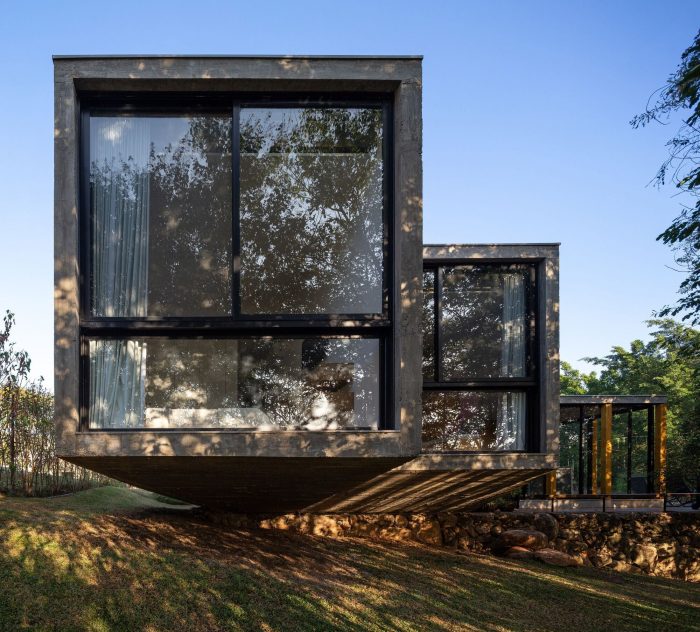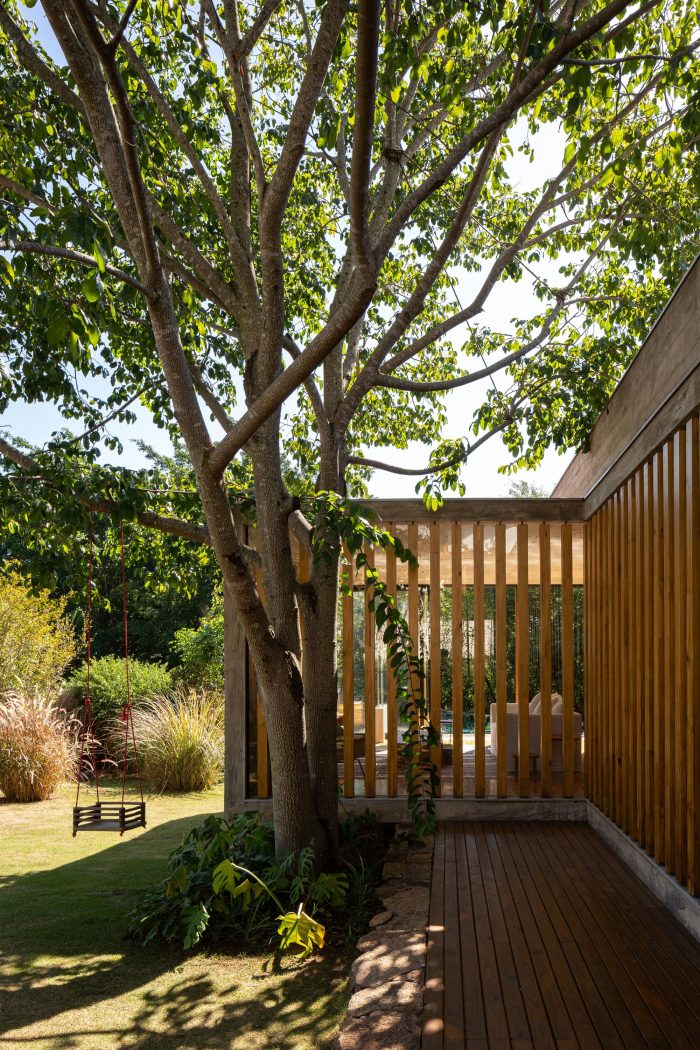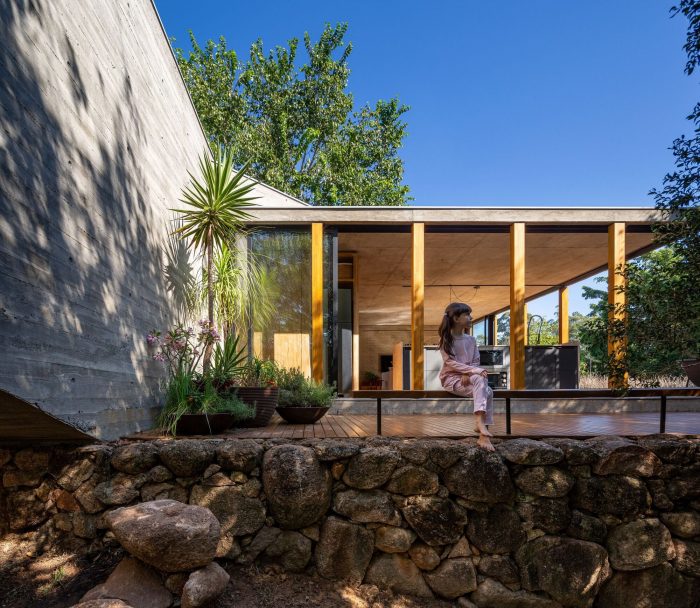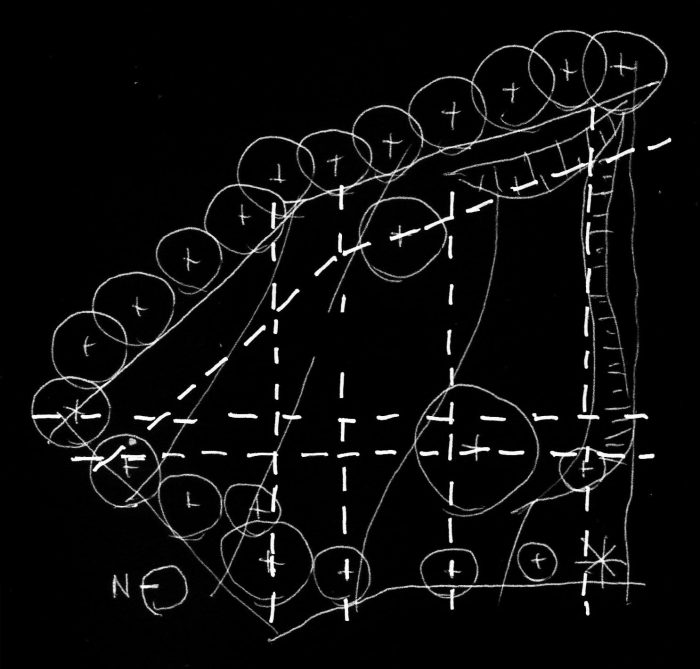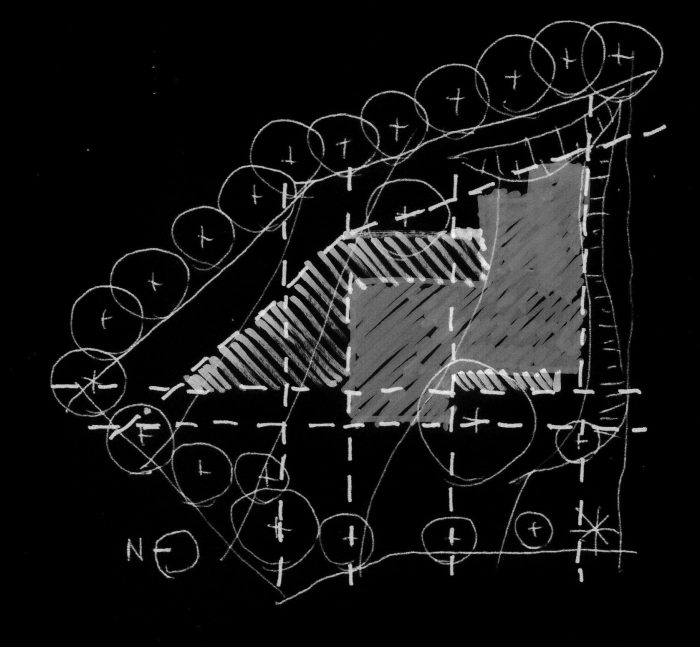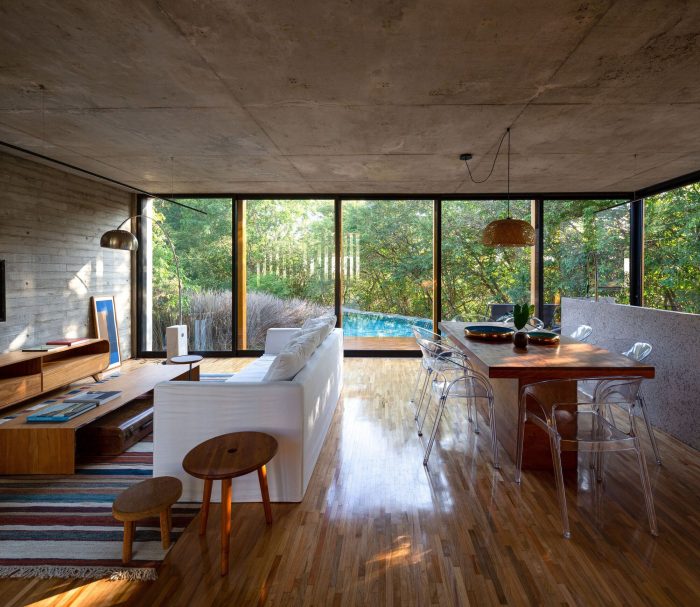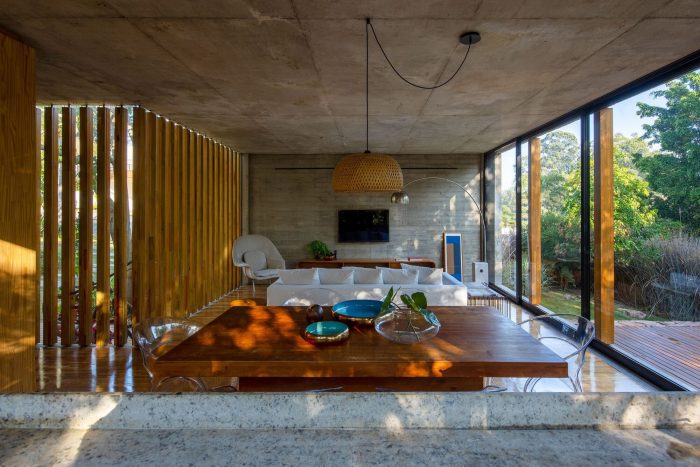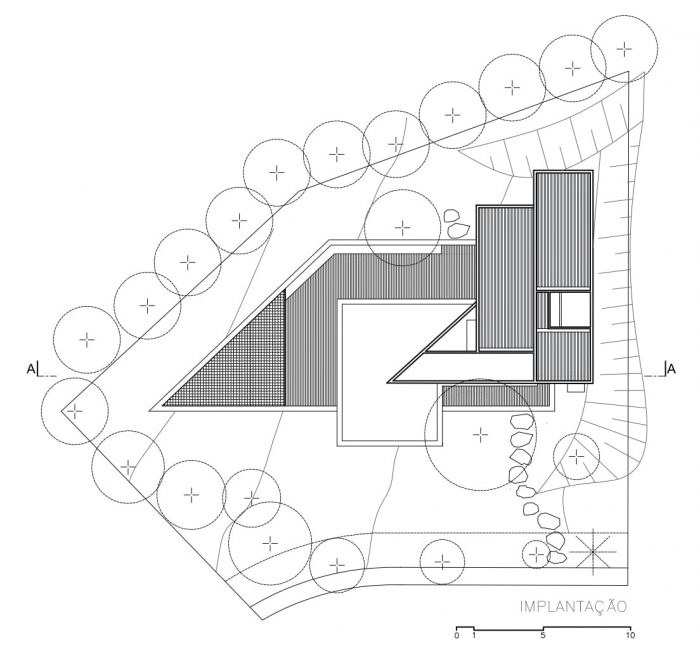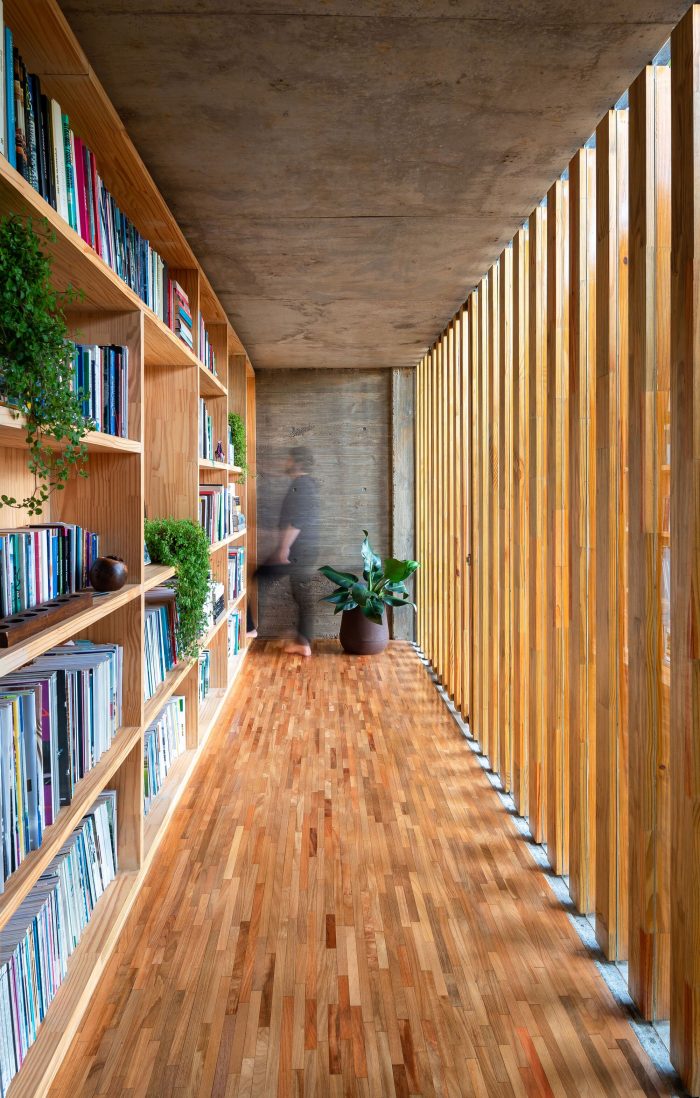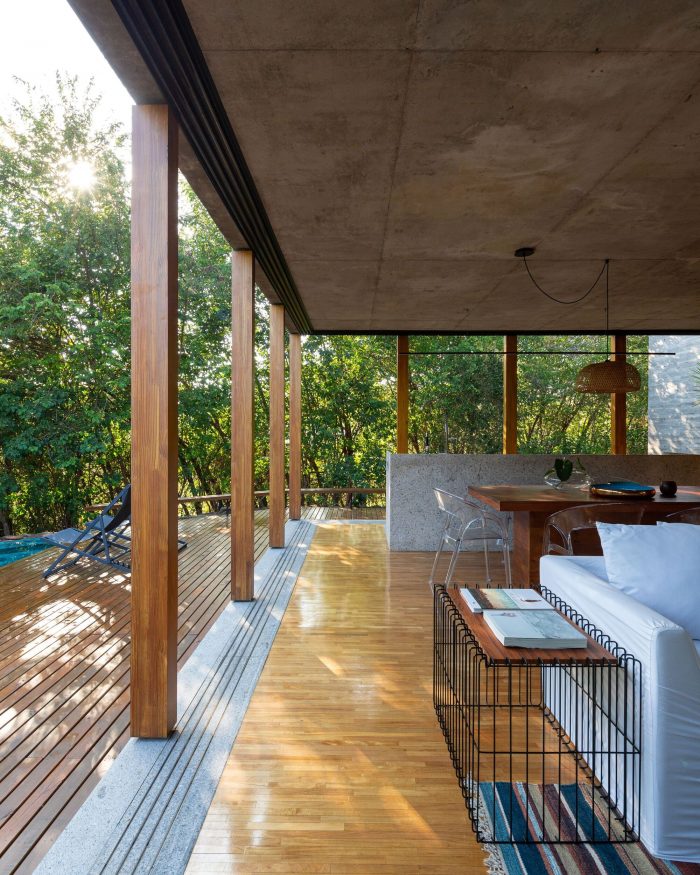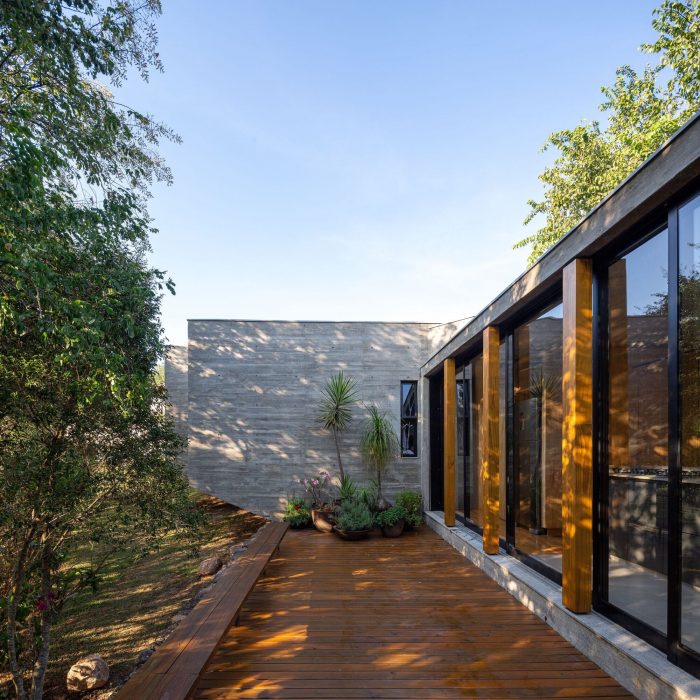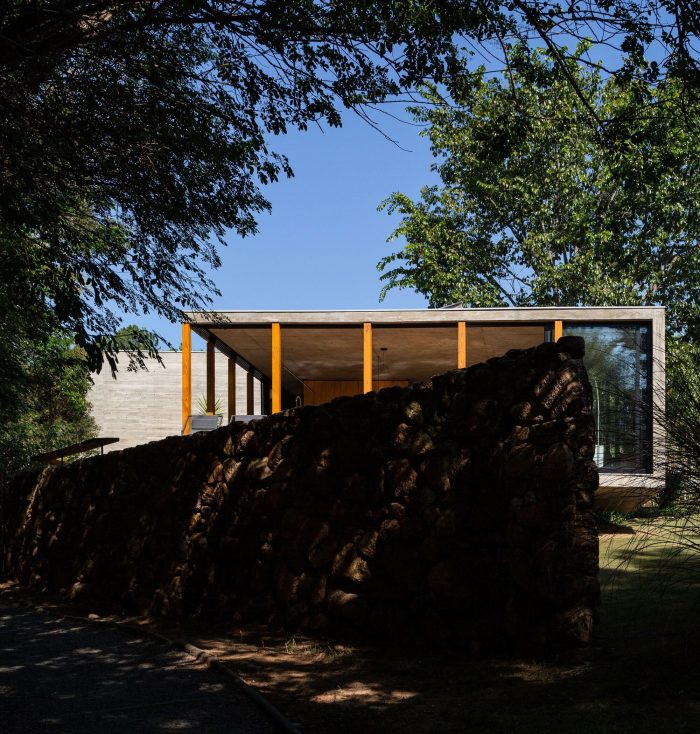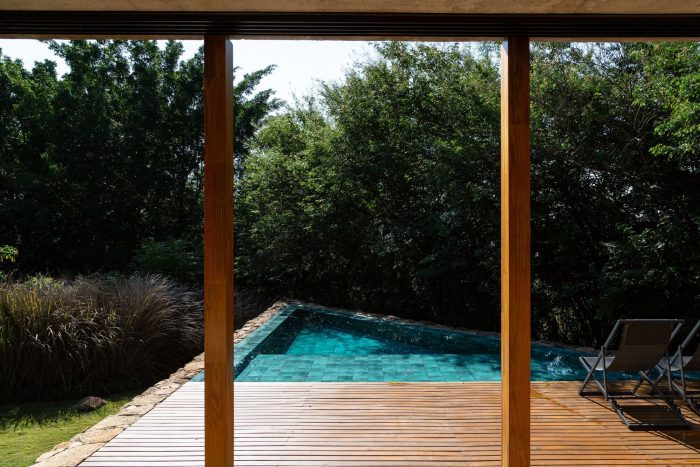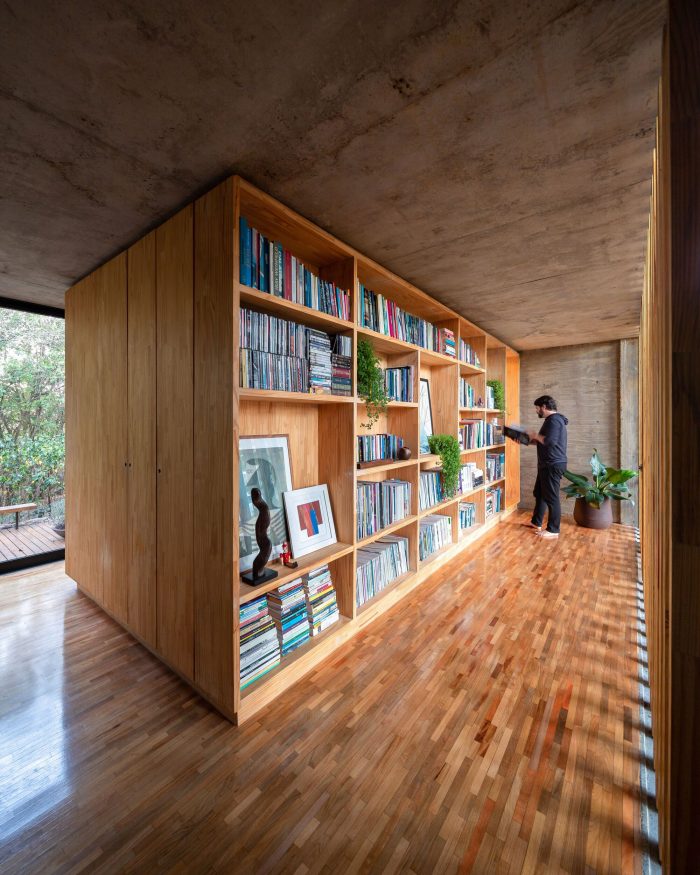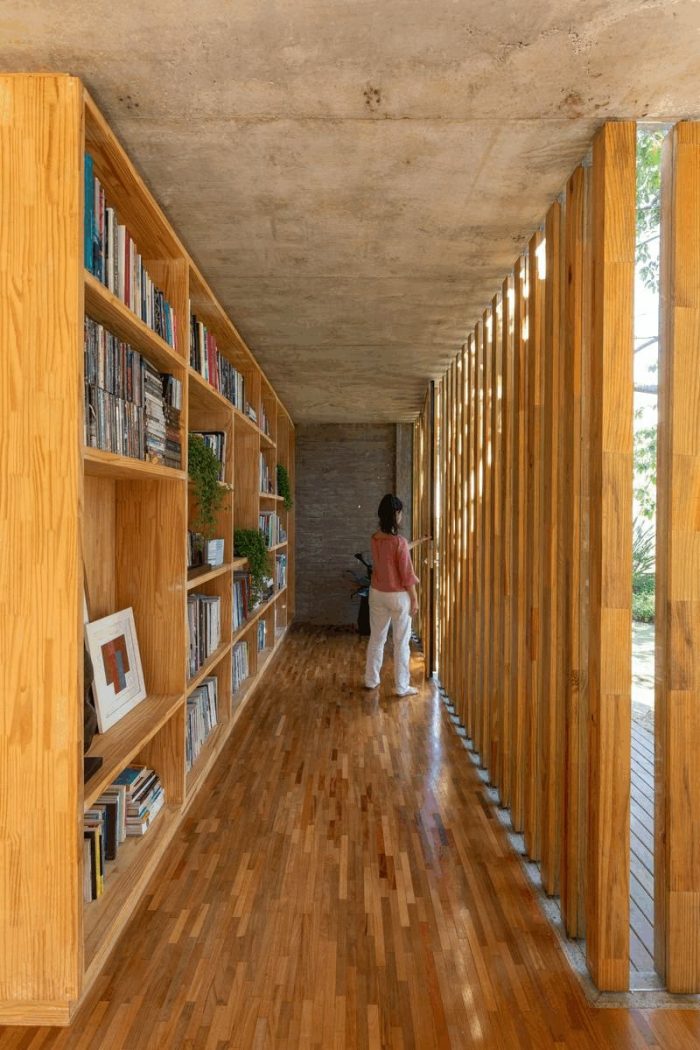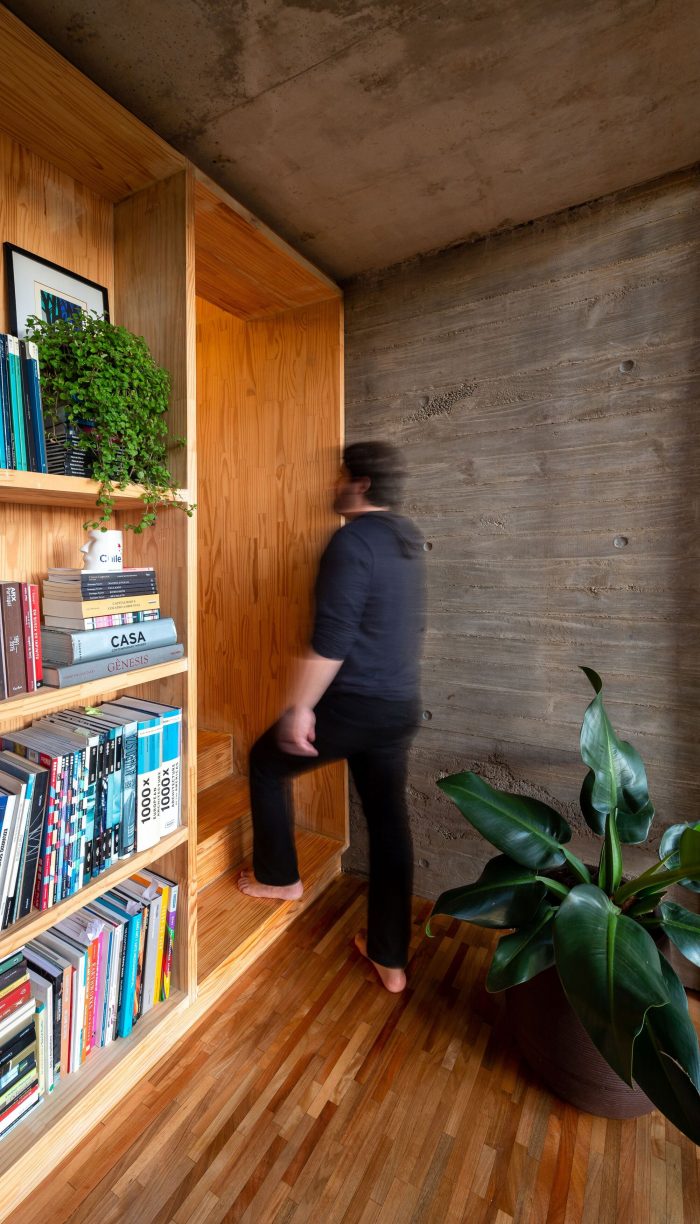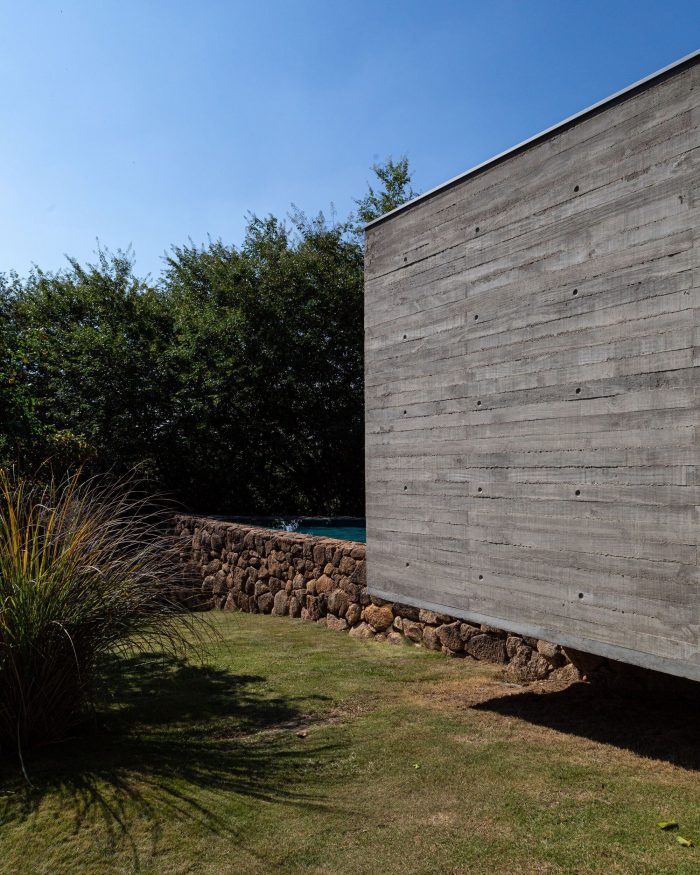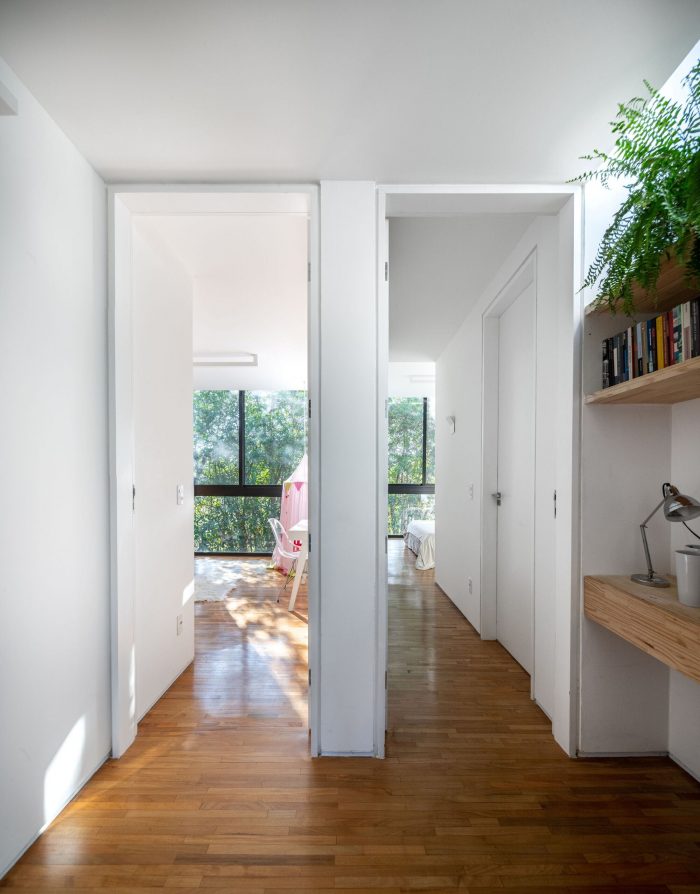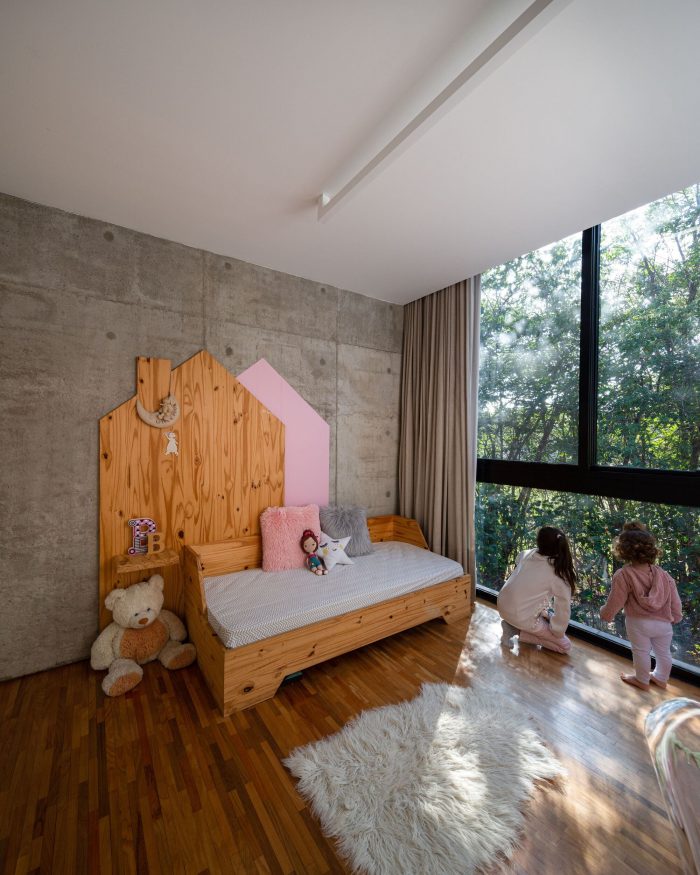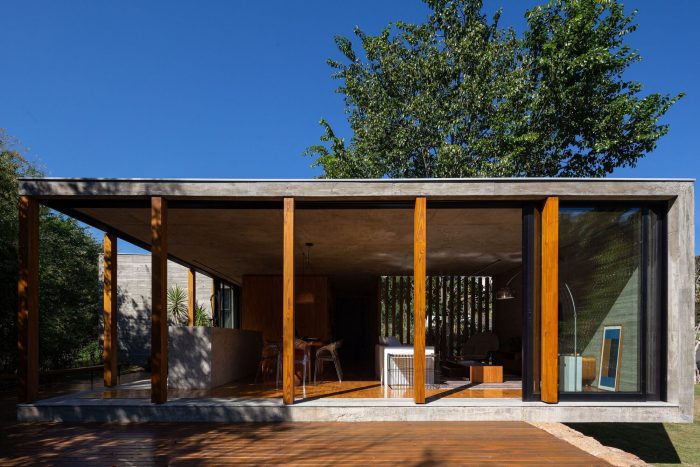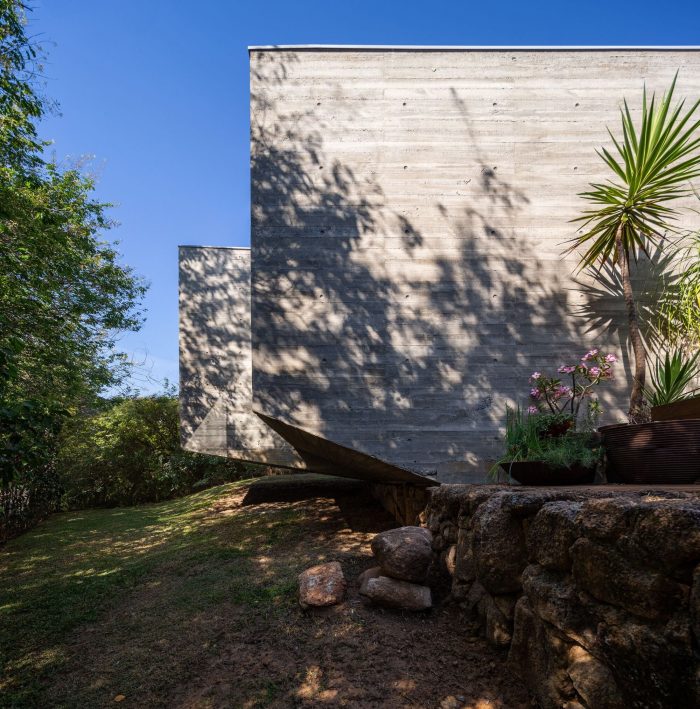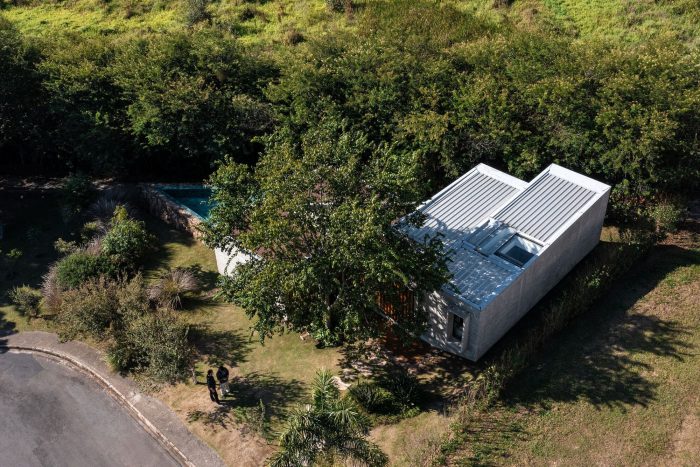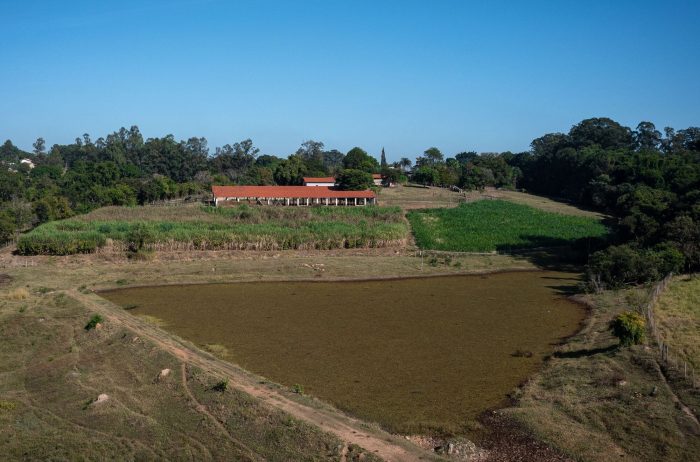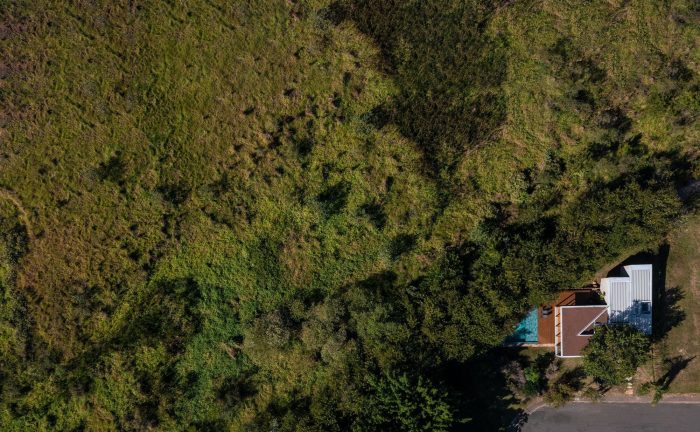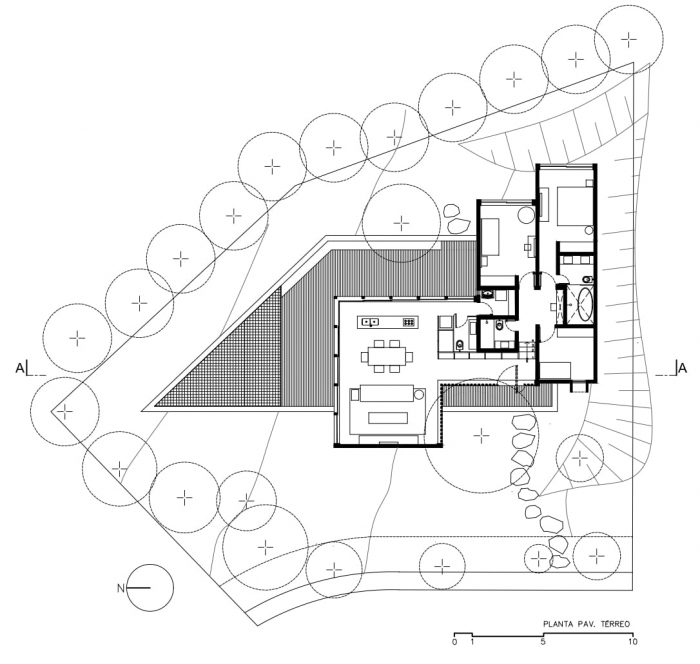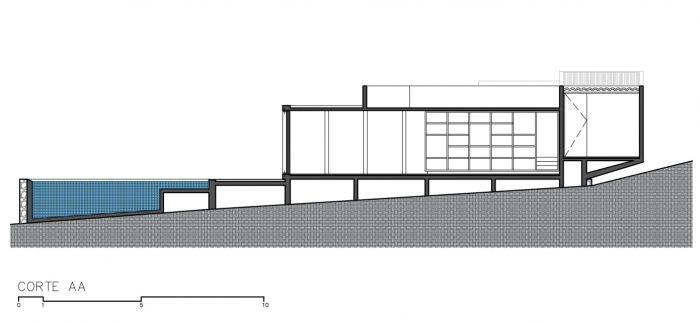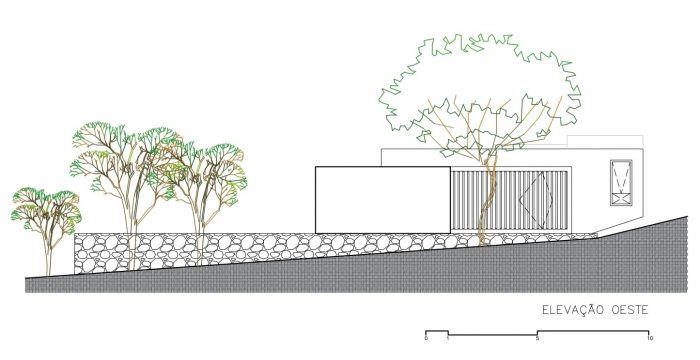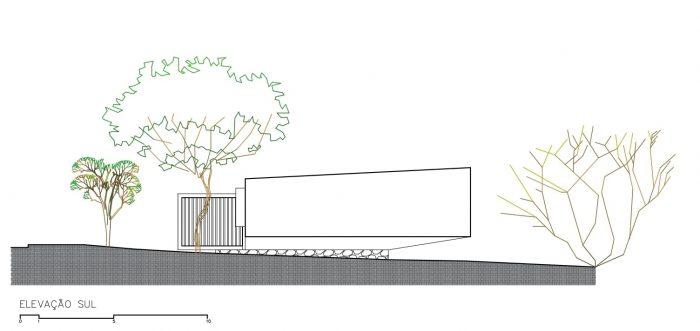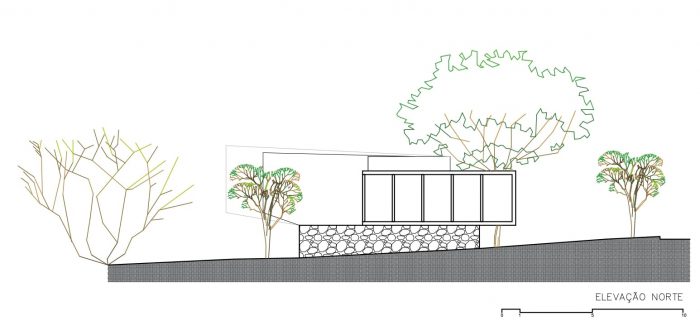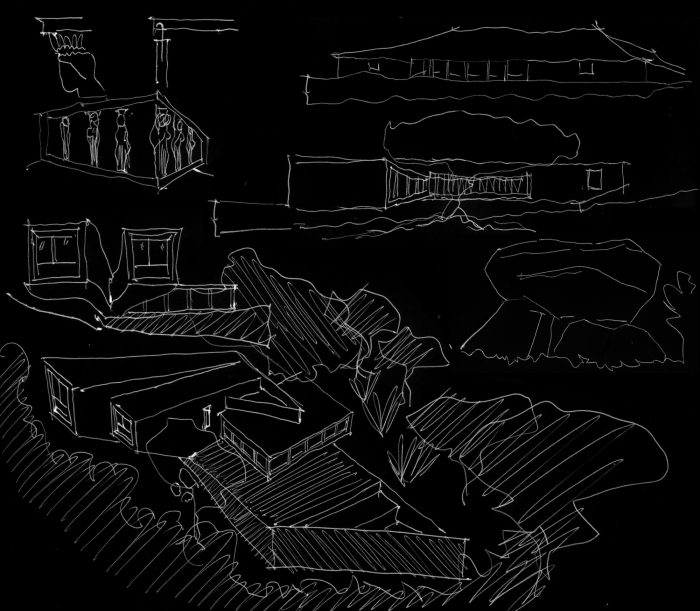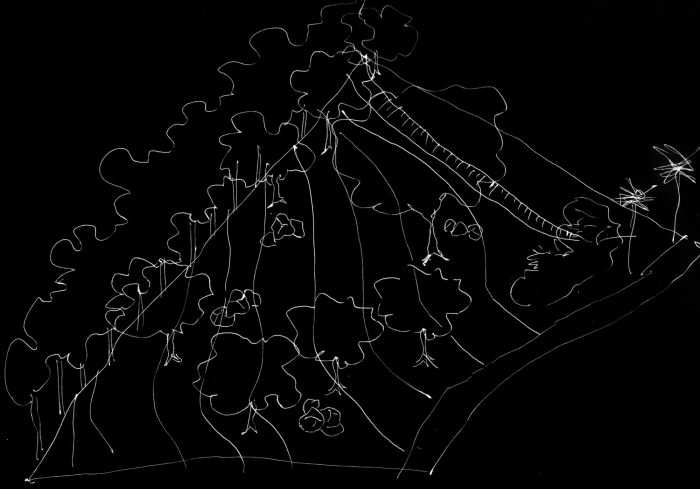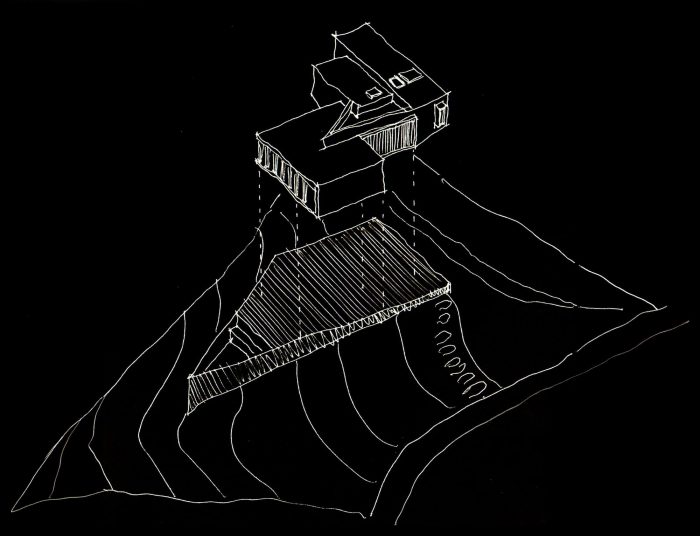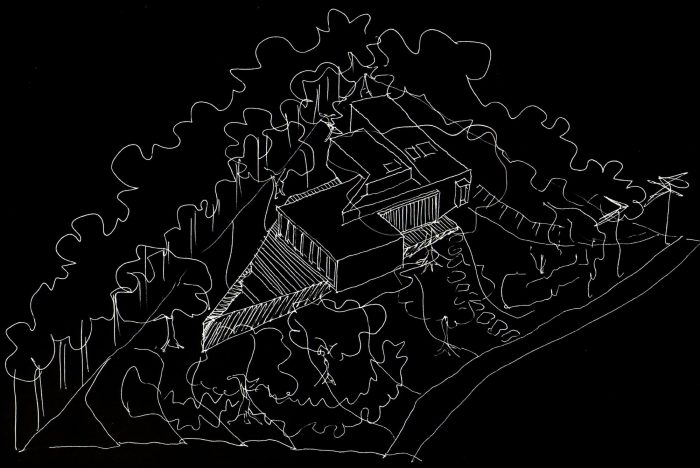该项目的实施地点的特点是存在着一个具有不同大小和品种的植被的树丛。以前,它是它所在的分配区的聚会和社交室,留下了这段历史的一些石头作为遗产,被补充和重新组合,重新组织和准备领土以容纳新的房子。它有一个向东北方向的小斜坡,朝向一个包含湖泊、洪泛区和大型本地树木的永久性保护区域,与该场地相邻。场地的美丽决定了这个项目,房子在与地形和景观的亲密关系中自行发展。
The site on which the project is implemented is characterized by the remarkable presence of a tree massif with vegetation of different sizes and varieties. Previously, it housed the party and social room of the allotment in which it is located, leaving some stones of this history as an inheritance, complemented and regrouped, reorganizing and preparing the territory to accommodate a new house. It has a slight slope to the northeast, towards a permanent preservation area that contains a lake, floodplain, and large native trees, contiguous to the site. The beauty of the site determined the project and the house developed itself in an intimate relationship with the topography and landscape.
为了把房子安置在树梢的高度,促进与那里的动植物的日常接触,设计了一个石头平台,保护一个技术区,并容纳一个小水池,其形状适合该地块的角落,与该地块附近的一个堰塞湖有某种相似之处。在这个几何形状的梯形块上面,上面没有形状的部分像巨石阵一样休息、滑动和弯曲,这在我们的农村地区非常普遍。在 “相邻、相抵、相随 “中,迈克尔-海泽尔似乎使用了这种俏皮的游戏。
In order to place the house at the height of the treetops, promoting daily contact with the flora and fauna present there, a stone podium was designed that guards a technical area and accommodates a small pool whose shape fits the corner of the lot and bears a certain resemblance to a weir present in the vicinity of the land. On top of this geometric, trapezoidal block, the upper, shapeless piece rests, slides, and bends like a megalithic formation, so present in our rural areas. In “Adjacent, Against, Upon”, Michael Heizer seems to have used this playful game.
在北面的社交区域,传统的结构逻辑被颠倒了,其中钢筋混凝土起着压缩作用,而木材起着牵引作用,提出了细长的胶合木(MLC)支柱作为钢筋混凝土 “帐篷 “的支撑,”伸展 “在绿色的前面。这些柱子,在模仿附近树干的垂直度的同时,再现了起源于分配地的农村结构的基本特征。它的有序和严格的重复让人联想到现在没有面孔、由松树制成的卡里亚蒂德。在西边,它更新并颠覆了 “圣保罗门廊”,用图书馆取代了小教堂,吸引了阅读和研究的乐趣。在东边,为了寻找从地段底部的巨大树木中过滤出来的旭日之光,两个管子被发射出去,寻找着它。此刻,豪尔赫-奥特萨的 “蒂萨实验室 “和豪尔赫-路易斯-博尔赫斯的一些 “想象的生命 “浮现在脑海中。
To the north, in the social area, the conventional structural logic is inverted in which reinforced concrete acts in compression and wood in traction, proposing slender glue-laminated wood (MLC) pillars as support for a “tent” of reinforced concrete, “stretched” in front of the green. The pillars, while emulating the verticality of the trunks of nearby trees, reproduce the elementary of the rural structures that originated the allotment. Its orderly and rigorous repetition is reminiscent of the Caryatids, now faceless and made of pine. To the west, it updates and subverts the ‘São Paulo’s porch’, replacing the chapel with a library, which invites the pleasure of reading and researching. To the east, in search of the light of the rising sun that comes filtered through the massive tree at the bottom of the lot, two tubes are launched, looking for it. At this moment, Jorge Oteiza’s “Laboratory of Tizas” and some of Jorge Luis Borges’ “Imaginary Beings” come to mind.
作品试图像景观中的假体一样融入其中:它适合树木留下的空隙。它自然地制造,但并不试图模仿自然的复杂性。将其几何化。在一个模棱两可的规模上,这个小而零碎的建筑也许不仅仅是一个避难所,也许还不如人们对房子的期望,它具有 “亭子 “的特征–一个被延伸部分包围的有盖空间–就像那些(仍然)存在于圣保罗城市周边的建筑。
The work seeks to fit in like a prosthesis in the landscape: it fits into the void left by the trees. It makes naturally but doesn’t try to mimic the complexity of nature. Geometrize it. On an ambiguous scale, the small and fragmented building is perhaps more than a refuge and perhaps less than what is expected of a house, taking on a ‘pavilion’ character – a covered space surrounded by extensions – like those that (still) exist in the surroundings of the cities of São Paulo.
在重读德拉蒙德的 “O Constante Dialogo “后不久设计的,它以一种 “物质翻译 “的方式捕捉到了诗歌的气氛,在与背景、自然、文化遗产和祖先直接沟通的练习中,同时向未来招手。一座亭子,从鸟儿的飞行、树叶中的风以及太阳、月亮和星星的 “运动 “中学习。一部不断对话的作品,在越来越需要对话的时代。
Designed shortly after the re-reading of Drummond’s “O Constante Dialogo”, it captures the atmosphere of the poem, in a kind of ‘materic translation’, in an exercise of direct communication with the context, nature, cultural heritage, and ancestry, while at the same time beckoning to the future. A pavilion-house to learn from the flight of the birds, the wind in the leaves, and the “movement” of the sun, moon, and stars. A work in constant dialogue, in times when it is increasingly necessary.
“不断的对话”
有这么多的对话。
与心爱的人的对话
相似的人
不同的人
漠不关心的人
相反的人
对手
聋哑人
着魔者
非理性的人
植物人
矿物
无名的
与自己对话
与夜晚的对话
星星
死者
思想
梦想
过去
更多的未来
选择你的对话
和
你最好的词
或
你最好的沉默。
即使在沉默中和与沉默中
我们对话。
卡洛斯-德鲁蒙德-德-安德拉德(Carlos Drummond de Andrade),在《初春的讨论和一些忧伤》(1977年)中说
“The Constant Dialogue”
There are so many dialogues.
Dialogue with the beloved one
the similar
the different
the indifferent
the opposite
the opponent
the deaf-mute
the possessed
the irrational
the vegetable
the mineral
the nameless
dialogue with yourself
with the night
the stars
The dead
the ideas
the dream
the past
the more than future
Choose your dialogue
and
your best word
or
your best silence.
Even in the silence and with the silence
we dialogue.
Carlos Drummond de Andrade, in ‘Discurso de Primavera e algumas sombras ‘ (1977)
Architects: idsp arquitetos
Area : 160 m²
Year : 2021
Photographs :Manuel Sá
Manufacturers : Bonaluce, Casa Varella, Decoratto, Elevare, Fahrer Design, GP esquadrias, Madel, Madelasca, Rewood, Saltense
Architects In Charge : Raul Penteado, Renata Boccia
Engineering : Omicro Engenharia, MVL Engenharia
Landscape Design : idsparquitetos
Consultants : Vértices Consultoria
Country:Brazil


